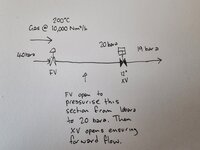figure8
Petroleum
- Mar 7, 2007
- 5
I'm familiar with the equations used to determine the forces resulting from fast closure of a valve in liquid service, however, I'm trying determine the instantaneous flow of a gas when a quick opening valve opens.
I'm pressuring the section upstream until I get a 1.0 bar differential over the valve (this is a 12" line size ball valve that opens in 5s). The flow in to pressurise the line upstream only needs a small Cv to pressurise the line in about 1 minute (circa 100). Due to the quick opening valve characteristic (and the Cv of a 12" ball valve being +22000) there will not be an opening sufficient to restrict the flow as soon as it opens.
As I understand it, following the quick opening on the valve, the pressure energy building up behind the valve will be converted in velocity as the fluid start to move and there will be a pressure surge. Is there anything i should be using to determine the increased flow at this instant vs the flow into the section that was pressurising it.
I have a feeling that it will require specific software to do the analysis but I'm just looking for a worst case flow at the moment of opening as i suspect the FIs on the line would not detect this.
Would a worst case evaluation based ideal gas equation to determine the number of moles in the section upstream and then determining the moles that would need leave the section to drop the pressure back to a point where the pressure driving force falls back to approaching zero then assuming that passes through the valve in the first second be a completely ridiculous way to determine this.
I'm pressuring the section upstream until I get a 1.0 bar differential over the valve (this is a 12" line size ball valve that opens in 5s). The flow in to pressurise the line upstream only needs a small Cv to pressurise the line in about 1 minute (circa 100). Due to the quick opening valve characteristic (and the Cv of a 12" ball valve being +22000) there will not be an opening sufficient to restrict the flow as soon as it opens.
As I understand it, following the quick opening on the valve, the pressure energy building up behind the valve will be converted in velocity as the fluid start to move and there will be a pressure surge. Is there anything i should be using to determine the increased flow at this instant vs the flow into the section that was pressurising it.
I have a feeling that it will require specific software to do the analysis but I'm just looking for a worst case flow at the moment of opening as i suspect the FIs on the line would not detect this.
Would a worst case evaluation based ideal gas equation to determine the number of moles in the section upstream and then determining the moles that would need leave the section to drop the pressure back to a point where the pressure driving force falls back to approaching zero then assuming that passes through the valve in the first second be a completely ridiculous way to determine this.

